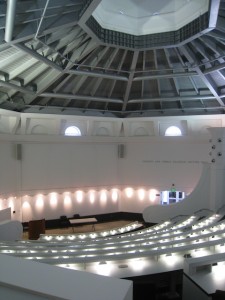I have spent many hours of my life teaching in college classrooms. Why are these rooms always so dismal? The worst don’t even have windows. And even when they are spanking new, they inevitably lack a crucial ingredient–architectural character. It is as if their architects, or perhaps it’s the college administrators, had decided that the ideal teaching space had to be neutral, bland, plain vanilla. In fact, the opposite is true. Classrooms should stimulate, not narcotize. I had these thoughts recently as I lectured at the University of Miami school of architecture, whose auditorium is in a building designed several years ago by Leon Krier. What a stimulating space! Also a reminder that while Krier may be a classicist, he is a modern classicist. The steeply raked auditorium had the kind of hard simplicity that can be found in the best early modern buildings of the 1920s.
On Culture and Architecture


This post is spot-on. Thank you for drawing attention to the lack of architectural stimulus in educational spaces. A sense-activating space has a rapid positive influence on the mind, dramatically increasing its production and efficiency.
As a designer of instructional spaces, I am constantly confronted with implementing cognition-inhibiting proposals for our grade-school students. I want to intervene in this process to establish pro-cognition design standards.